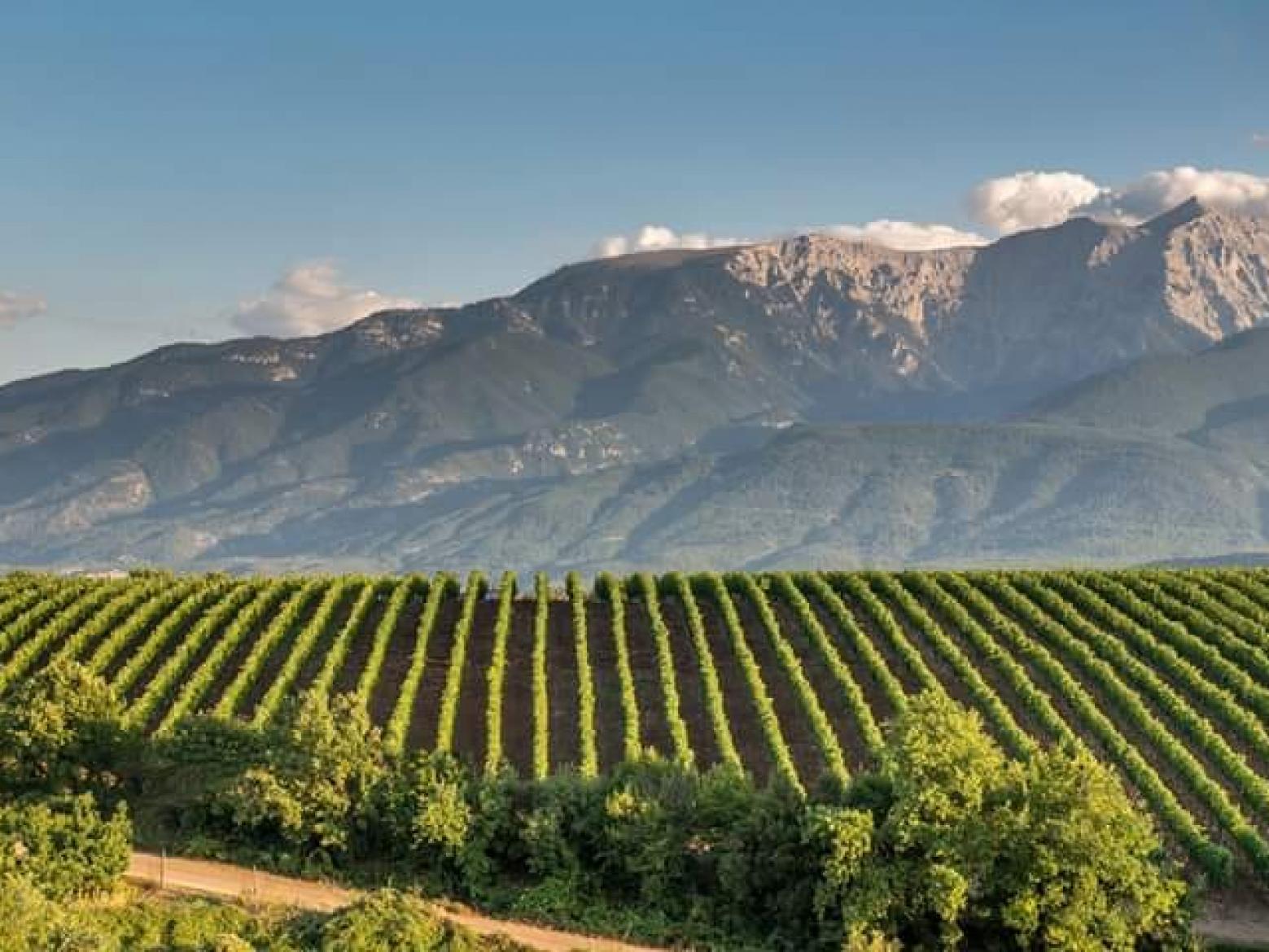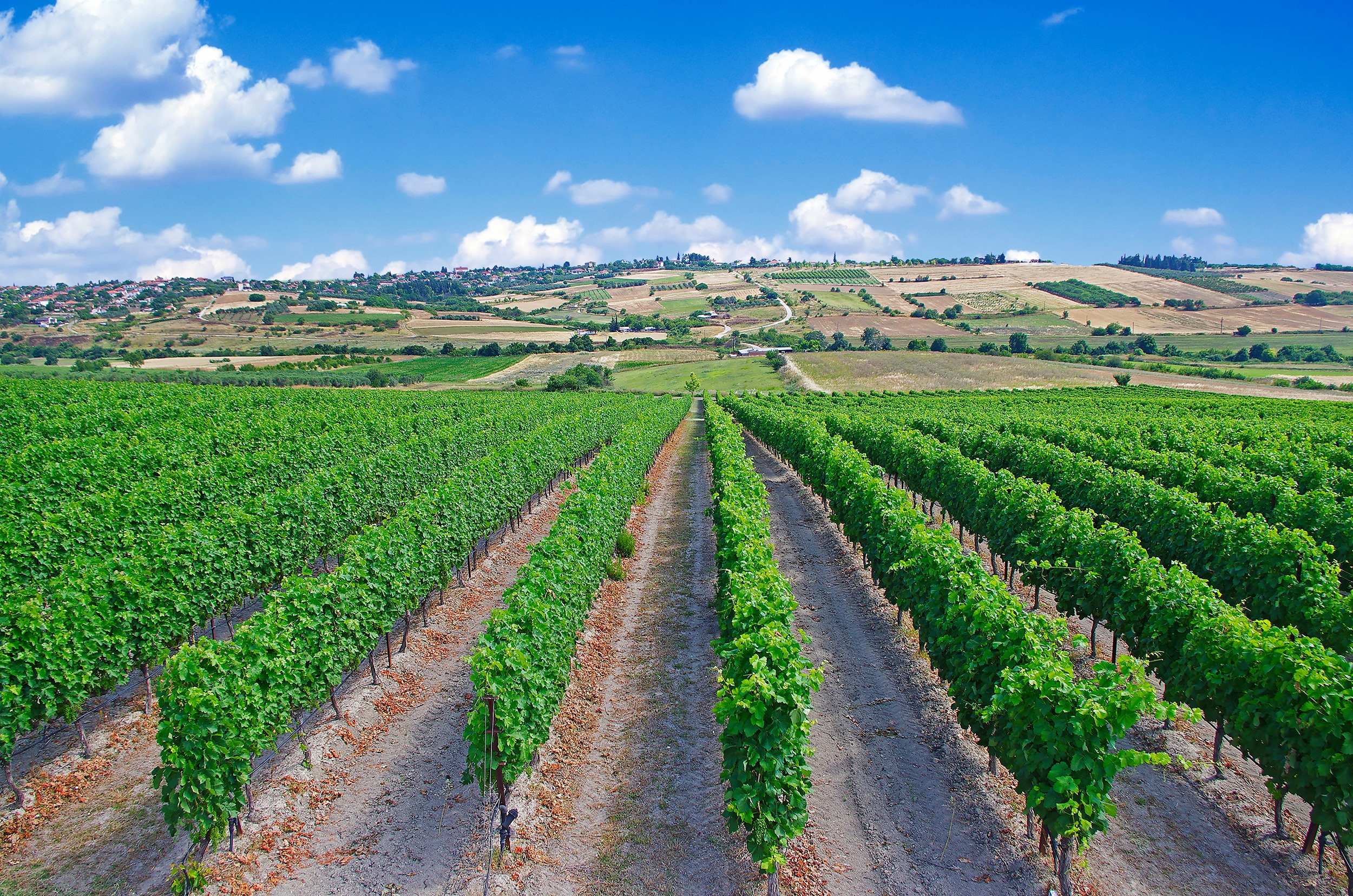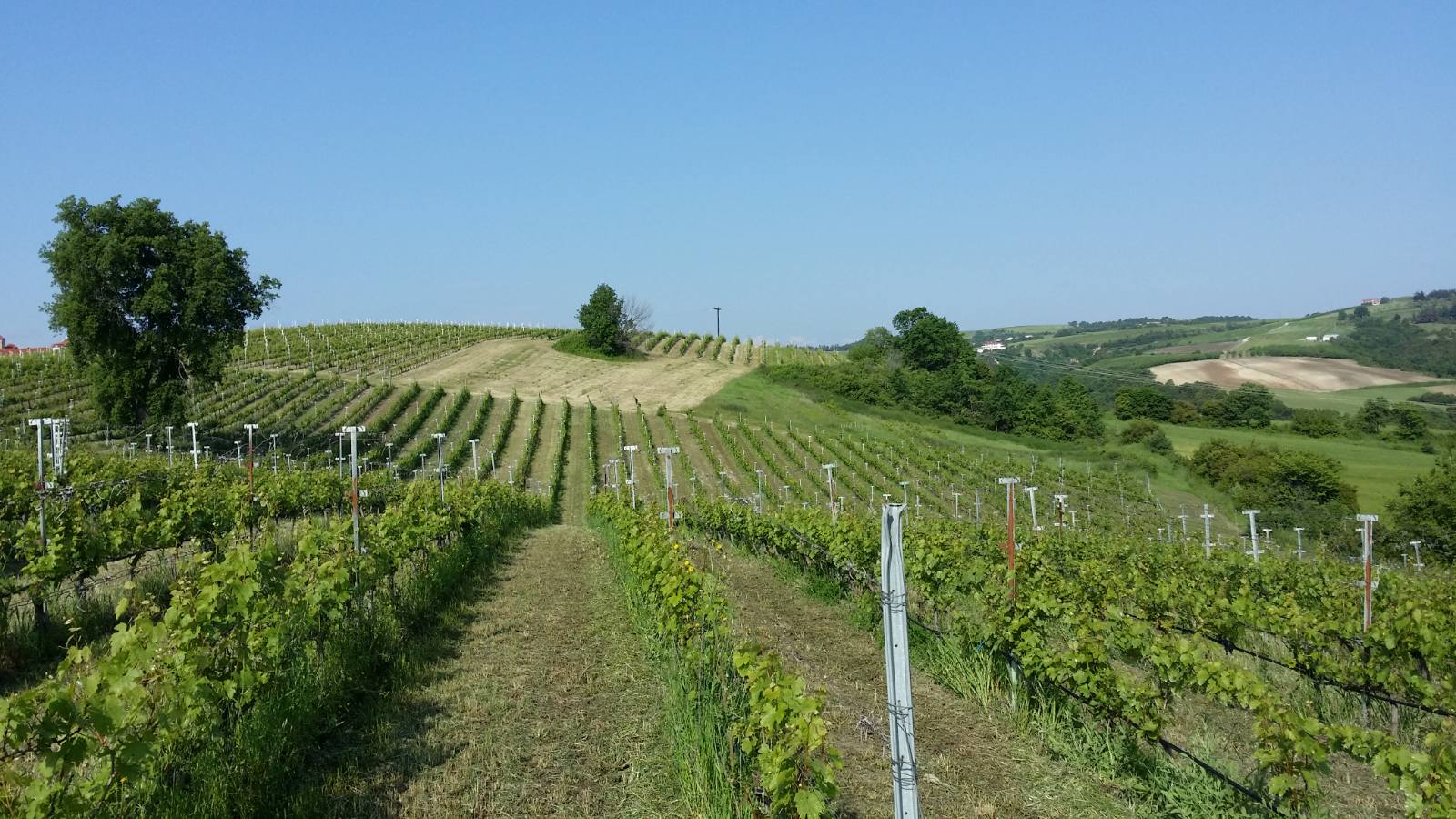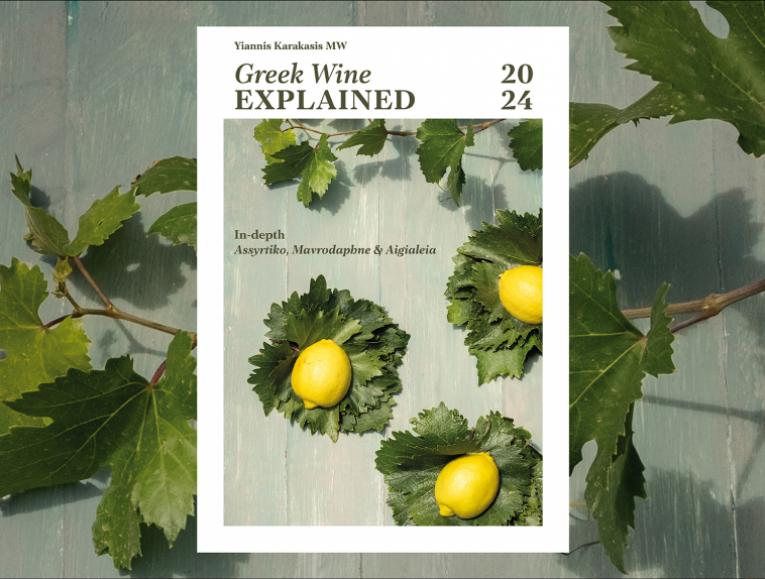Discovering Pieria
By Olga Antoniadou
I have gone by so many times on my way to other places, but have only stopped here once, and I felt somewhat guilty about never taking the time to discover this part of Greece and the wineries in the area. Enveloped between Mt Olympus, the Pierian mountain range and the bay of Thermaikos to the east is the beautiful area of Pieria (in the north eastern part of Greece), marked by undulating hills, favourable growing conditions, and a climate that caresses the vines. Not much written about, as it is caught between its famous neighbours Naoussa and Rapsani, and is only now a young adult. Rather fertile (the producers I spoke to all green harvest), with small holdings and farmers who, in the past, grew vines and other produce. When I took a closer look, to my amazement, I discovered about fifteen wineries spread across the region. Most, officially became wine producers in the '90's. I noticed that many grow international varietals and rather more recently native Greek varieties and when I asked about this they all gave me a similar answer, “the region developed late, is still in search of an identity, had to find a road to market and the international varieties were more recognisable and fashionable at the start”.
Pieria has been making some interesting wines, and perhaps the liberty of not being confined within the rigid limits of PDOs has allowed for more experimentation, both with methods and varieties. I spoke to four of the wineries (from south to north) and would have liked to be able to include more, but that would have made a very long read (that is also why I narrowed my tasting notes down to two wines from each).
Situated in the western part of the region, in Rachi, is a 7ha vineyard at 300m altitude, which is farmed organically (pictured above). The winery was founded in 1997, is open to visitors and about 40% of the production is sold at the cellar door. Their aim is to up that to 60%. Apostolos Kourtis, the owner, tells me that he grew up in a family of farmers who had grown tobacco, later cherries and he switched to viticulture. The old warehouse is the cellar and attached is the tasting room. Their total production is 18-20 000 bottles and could progressively go up to 35 000, but they choose to control their grape production by green harvesting so as to source the best fruit.
The climate is described as continental dry, it rains mainly in spring and in summer (nearer full maturation) and in the autumn they enjoy diurnal variation that can be a good 10oC difference in temperature. “This makes our wines crunchy, they retain their aroma and are fresh on the palate. We strictly select the grapes that go into our labels and harvest twice, with the grapes from the second harvest going into bag in box wines”. The microclimate is influenced by Mt Olympus, the Pierian mountain range and the sea. “We have many night winds that are northeastern, in the morning the breezes from the sea, then from the Pierian mt range and in the afternoon the Olympiatis. This gives us dry conditions and the vines are well aerated”.
They cut natural vegetation and leave it on the ground, will use copper or sulphur treatments only if necessary, are experimenting with funghi for disease control and will only use compote and manure to fertilise. The soil is of medium composition, with the top 20cm consisting of sandy-clay-loam with much CaCO3, sitting on gravel and rock. They grow Assyrtiko, Vidiano, Trebbiano of the white varieties, and Xinomavro, Agiorgitiko, Syrah, Merlot and Cabernet Sauvignon or the red. “Our Vidiano was one of the first to be vinified in Northern Greece and I remember that at the 2018 Oenorama all the Cretan producers had come by to try it. Vidiano needs much care during maturation because it easily increases its sugars and loses acidity. In terms of our Xinomavro I think that in some years it is very close to a more modern Naoussa and our Agiorgitiko is crunchier than that of Nemea”.
Nychta ? 2018 90% Vidiano 10% Assyrtiko Aromas of citrus fruit, lemon, peach, dough, hazelnuts and wet rocks makes a complex wine, nicely balanced acidity with the fruit, that is textural, fresh with a long lemony, mineral aftertaste.
Xinomavro 2017 Wild berries, sweet tomato paste, black olive paste and star anise, with nice acidity, but a little young for the tannins, make a wine that is in the ‘modern’ xinomavro approach, with typicity, a long savoury aftertaste, enjoyable even now, but even better if kept a few years.
I spoke to Nikos Chrysostomou who owns the winery with his brother Elias. He tells me that there was a long tradition of winemaking in the family, but they officially started the winery in 2010. It is situated in Pydna with the winery actually within the settlement and the vineyards spread out around it. They work 12.5ha, which are at an altitude of 80-115m (pictured below). They have 8 sloped vineyard sites, some facing north and some southeast and the make up of the soil is sandy-clay with a high proportion of active limestone. The climate here is described as mild (just 2km from the sea in a straight line), the summer is also mild with the cooling effect of the Olympiatis wind, and is an area which is particularly dry, “there are salt flats very close, exactly because it is very dry”.
They farm sustainably, use mild interventions, natural growth is cut and left on the ground, green harvest, and prune in a double Guyot. They want to keep their production low so as to source healthy fruit. The varieties they grow are Malagousia, Assyrtiko, Sauvignon Blanc and Chardonnay of the white (recently they've planted Vidiano), and Xinomavro, Limniona, Cabernet Sauvignon, Merlot and more recently Syrah of the red. In charge of winemaking is Angeliki Biba, who worked in Bordeaux a few years before settling in Greece.
I ask Nikos what he considers the trademark of the area and he says, “In all honesty I think that because the area has small producers, who all started around the same time, we needed to explore the character of the varieties and we needed to be able to offer wines that cover the taste of a wider audience because we weren't known for a particular variety or style, so we're all in search of an identity”. I ask how the wines differ from those of other regions and he says, “I think my wines are more aromatic if compared with those of neighbouring areas, and my Malagousia has more body and aftertaste and not such an explosive aromatic character (they use battonage)”. The winery is open to visitors by appointment, the production is at around 40 000 bottles, they make quite a few labels which are mostly sold locally, with few exported or sold in Athens.
Malagousia 2018 Beautiful aromas of guava, papaya, peaches, melon, banana with a minty undertone, paired with nice freshness, medium body and a long peachy aftertaste, make a Malagousia that is complex and delectable.
Kalogero 2019 A Syrah that hasn’t been marketed yet with an amazing 15,5% alc which needs to become more incorporated. A young wine, with aromas of blackberries, black cherries, damson fruit, lavender, sweet spices and a whiff of tobacco and graphite. On the palate slightly peppery, it retains freshness, despite the alcohol and the rather present tannic load and has a fruity, alcoholic finish. Smooth, despite its youth.
Nadir Winery
Now why on earth would anyone want to call their winery a name like that? Is it some kind of understatement? That you can only go up from there? You know me by now, I couldn’t resist the question. “Nadir didn’t always have a negative connotation. To me it is the lowest point, the very beginning of something”.
The winery is located in Paliostani, Pieria and I spoke to the owner, winemaker Ioakim Mavridis, who is self-taught, “I was young, available, had a vision, so I read every German book I could get my hands on about vine-growing and winemaking”. His vineyard (pictured below) is 1.45ha, planted in 2007, and in 2008 he completed his winery, which is open to guests. He grows Syrah, Agiorgitiko, Cabernet Sauvignon, Assyrtiko and Riesling. His soil he defines as sandy-clay loam, his vineyard is east facing with a 10% inclination at 320m altitude, and is open to breezes. He farms organically and although he was organically certified he dropped the certification, “all the bureaucracy involved just took up too much of my time and I thought to myself it doesn’t really make a difference. What matters is how you treat your vines and I’m sure anybody who tries my wine will be able to tell that this is an organic wine”.
His production is minute, about 4000-5000 bottles in all, and he wants to keep his output at 300kg/1000m2. “I want the time I’ve got to go into my vineyard, I do everything by hand and I will pass over the vineyard again and again. Most of the work is done slightly later than is usual, very slowly. I want to give the vine time to give me the best possible fruit. I prune in a double cordon, because I find that it is more balanced, I always burn the prunings, I pinch the shoots 3-4 times, and green harvest. Also, I select out bunches and grapes in the vineyard during the harvest to make sure I only keep healthy fruit”. He tells me that the weather in September is quite unpredictable, which means he can’t grow varieties that are late-ripening because that would mean harvesting unripe fruit. Basic problems in his area are downy mildew, powdery mildew and grey rot.
In the winery, during the last two years, he vinifies with ambient yeast, “temperatures can be quite high sometimes” he says, in used barrels and only about half the permitted quantity of sulfur is used.
He makes three labels Avus, Patris, Matris, which for now are sold at the cellar door.
Avus 2015 100% Syrah made of overripe grapes and spontaneously fermented at high temperatures give a wine with aromas of dark fruit preserve, dried herbs, black pepper, some tobacco notes, some earthy and meaty notes, with an amazing alcohol level close to 16%, which is not overpowering, with a nice juicy finish. I would have liked a little more freshness, but in all a very interesting wine.
Patris 2015 A blend of different red varieties that is more aromatic and capturing on the nose than on the palate, dark, intense, toasty, with aromas of black berries and a hint of sour cherries, liquorice, dried herbs and flowers, tobacco, cocoa, rather chalky tannins, again amazingly high alcohol of almost 16%, and a bitter, long alcoholic finish. Once again I would have liked more freshness, but again an interesting wine.
Ktima Pieria Erateini
I spoke to the winemaker Andreas Pantos who gave me much information about the winery and the area. He studied chemistry and oenology, started in the wine business in 1993, worked for the Tsantali winery for about a decade, consulted wineries and in 2007 started the joint project with Pavlos Argyropoulos in Kolindros, Pieria. “We revived an old vineyard around the Monastery of Agios Athanassios, that had been abandoned in the ’20’s (last picture below). The landscape there is full of hills and ridges and our vineyard is at the top of a hill at 300m altitude. It covers an area of 15ha and we have East and West facing vineyards. All around you have oak trees, from the vineyard you can see down to the sea and we usually have refreshing afternoon breezes coming from the south, locally called Olympiatis”.
Apparently, ages ago the area was a lake (they are in the broader area of river Aliakmonas) and they often stumble upon river rocks, pebbles and shells. The terroir is clayey, sandy limestone with patches that are sandier than others. They grow Assyrtiko, Chardonnay and Malagousia of the white varieties, Guyot pruned and trained, and Syrah, Xinomavro, Cabernet Sauvignon and a tiny bit of Kolindrino of the red varieties, Royat pruned and trained. They farm organically and are in the process of acquiring organic certification. Their production is about 80 000 bottles depending on the vintage.
I am told that their Assyrtiko retains its character and that it is best drunk a couple of years after the harvest. I ask what their differences are from neighbouring Rapsani and Naoussa and he tells me that Rapsani has more schist and iron in the soils. Also the climate in Kolindros is mediterranean. He also adds that the clay in the soils of the area gives the wines more body, softer tannins and good phenolic maturation. “The Xinomavro in our area is ‘lighter’ compared to that of Rapsani and Naoussa. I would call it more feminine”.
Meta 2018 An orange wine made of 100% Assyrtiko. This label hasn’t been made for quite a few years and has switched variety. Aromas of rooibos tea, honey, dried caramelised citrus fruits and dried herbs, with a hint of tobacco and nice tannins, makes a very balanced, savoury and interesting wine. One of the best orange wines I have tasted.
Gymnos Vassilias 2012 Mainly Syrah with about 15% Kolindrino gives a very concentrated, bold wine with aromas of sweet dark cherries, prunes, figs, boysenberries, and black currant syrup, much sweet spice, dark chocolate, with the oak barrel aromas slightly overpowering the fruit, rather low acidity and tannins that are a touch more chalky than I would have liked.
Pieria is the place I want to visit next and I’m already excited with the thought of it. I will then write a second part as I have left out one of my favourites in the area, but with good reason. So, for now, my wish is for Covid to die out, for travel restraints to lift, for bars and restaurants to re-open, and for social life to resume. Wouldn’t it be lovely?







